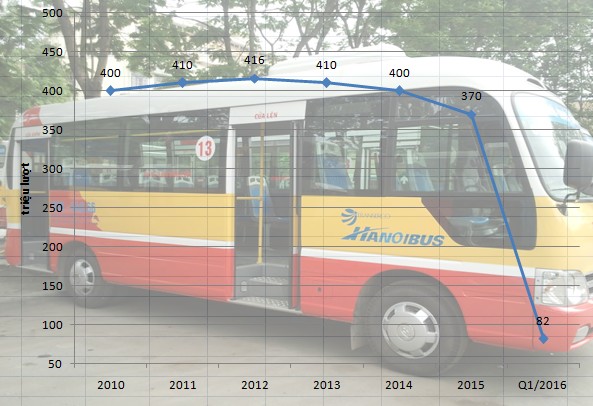According to the Q1/2016 summary report by Hanoi Transport Corporation (Transerco – Hanoibus), bus passenger transport volume reached over 82 million passengers. This figure is significantly lower compared to 95.4 million passengers in the same period of 2015, representing a decrease of nearly 160,000 passengers per day. This downward trend has been continuous since 2012, despite Transerco’s claims of “maintaining stable transportation volume” and “ensuring targets.”
 Transerco passenger transportation volume chart from 2010 to 2016. Source: Transerco
Transerco passenger transportation volume chart from 2010 to 2016. Source: Transerco
Reasons for the Decline in Bus Passengers
Hanoibus cites three main reasons for the decrease in bus passenger volume:
1. Increased Use of Personal Vehicles
The explosion of motorbikes at a rate of 3 million vehicles per year, along with the increasing number of electric bicycles, electric motorbikes, and cars, is considered the primary cause. However, in many countries, public transportation like buses plays a role in limiting personal vehicles. Conversely, in Vietnam, buses not only fail to curb the growth of personal vehicles but also face intense competition, leading to a decrease in ridership.
2. Reduced Fuel Prices
Lower fuel prices reduce the competitiveness of buses compared to taxis, motorbike taxis, and electric vehicles. However, revisiting the period of 2013-2014, when fuel prices surged, bus passenger volume still declined. This suggests that fuel prices are not the decisive factor.
3. Traffic Congestion
Traffic congestion, a “specialty” of Hanoi, is also considered a contributing factor. Although Hanoi resolved 10 traffic congestion points in 2015 by accelerating traffic project progress and reorganizing traffic flow effectively, there are still 44 other congestion points needing resolution. The main causes are excessive traffic volume, poor traffic law compliance, and construction projects occupying road space. The question is whether building more roads will truly solve congestion or exacerbate the situation, affecting bus operations?
The Real Reasons Behind the Bus Crisis
The above three reasons are only part of the problem. The deeper cause lies in the urban transportation infrastructure not keeping pace with the scale and speed of population growth and vehicle ownership in Hanoi. This makes buses unable to meet the travel needs of residents and unattractive as a substitute for personal vehicles.
When passengers no longer feel that buses are safe, convenient, and fast, they will turn to other means of transportation such as personal vehicles, taxis, or ride-hailing services. The question is, as Hanoi’s population grows rapidly, where have tens of millions of passengers who no longer choose buses shifted to? If they all switch to using personal vehicles, how much greater will the pressure on the city become?
Additionally, several other factors related to bus culture also detract from this mode of transport: jostling and pushing when boarding/alighting; poor hygiene awareness; pickpocketing and harassment; the image of buses driving recklessly and emitting black smoke…
Solutions for the Future
Hanoibus has proposed several solutions such as operating a “5-star” standard bus system and the BRT rapid bus project. However, the effectiveness and investment costs of these projects remain controversial. More comprehensive and effective solutions are needed to improve service quality, attract passengers back to buses, and contribute to reducing traffic congestion and environmental pollution in Hanoi.
